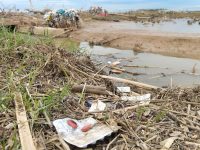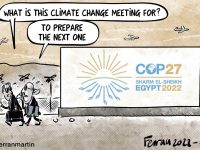The planetary crisis of the Anthropocene
Cultural evolution and environmental change
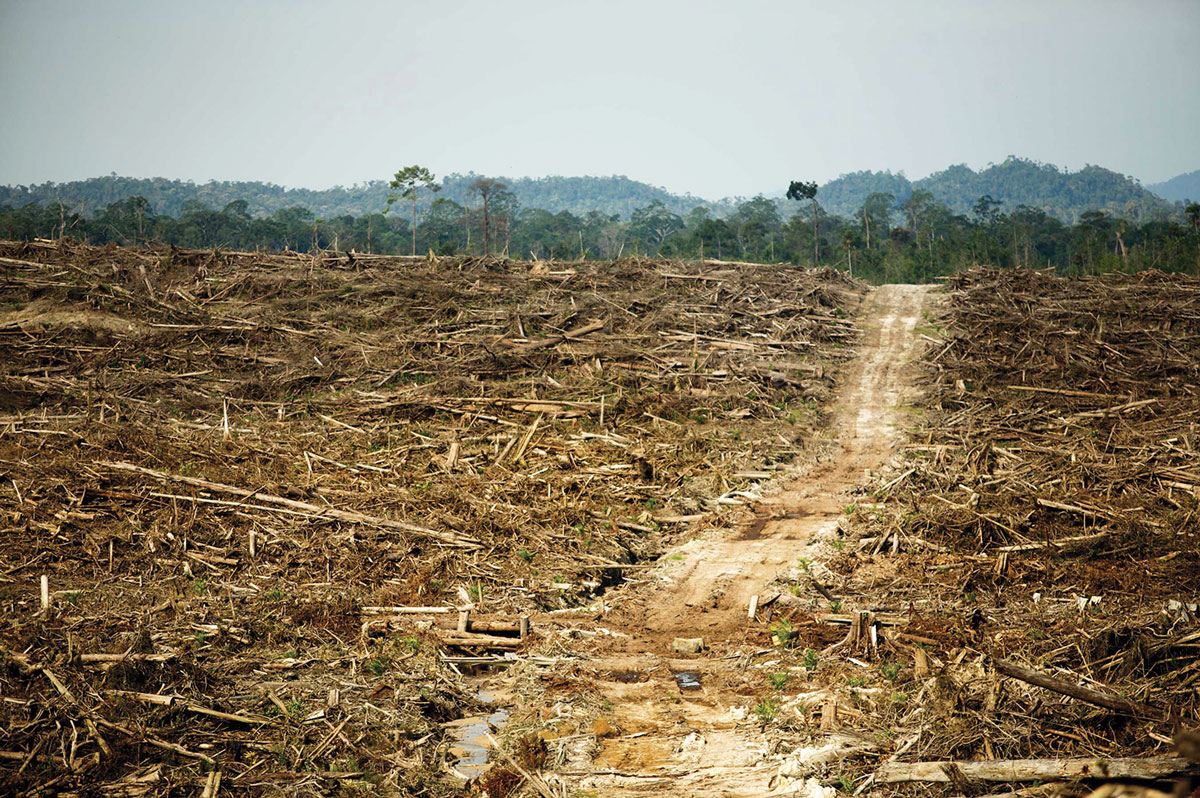
We are living through a crisis which we call Anthropocene. The determining force in this period is the expansion of humankind as the result of a new biological process, cultural evolution. This has allowed us to construct an enormously extensive niche, thanks, above all, to the increased use of exosomatic energy. The growth is accelerating rapidly and the impact on our socio-ecological structure is unpredictable. Environmental change exerts new selective pressures on human societies, which try to adapt, which in turn, forces new changes. Our demographic growth and improved living conditions are threatening resources and even our basic life-support processes but, even though we study their ecological impact, their causes are social. The destruction of cultures and biodiversity is the heritage of colonialism, even though it is now following different paths or being played out by different actors. We need to generate universal messages, without any attempt to perpetuate Western supremacy and the ideology of indefinite progress, by making an intercultural effort to reach a consensus on universal values and to generate the corresponding institutions.
Keywords: cultural evolution, coevolution, environmental change, niche construction, universal values.
Introduction
Very often we ecologists are asked to discuss environmental problems. However, the origin of these problems is not ecological, but social and cultural, and so are their potential solutions. Ecologists try to understand how ecosystems and species function under conditions which vary in their changeability. We can warn about some of their possible reactions in hypothetical future scenarios, but we cannot predict what will happen. Ecological systems, as well as socio-economic and cultural systems, are too complicated to be predictable. What seems like a small change today may have unexpected effects in the future. It is also common for ecologists to make lists of possible catastrophes, but we have talked about these lists so often that they have become boring or they create feelings of helplessness among those who read them. Here, I will approach these issues from a different point of view, starting from a general idea of how we have ended up where we are.
Culture and biology
Culture was born from biological evolution in several species and it expanded rapidly in Homo species, of which only ours remains today. Cultural characters (words, artefacts, ideas, etc.) change (variation) and variants have different survival and reproduction rates (selection and drift) and are transmitted via social mechanisms such as imitation or explanation (inheritance). Like biological evolution (Mesoudi, 2015), these three conditions are all that is required for cultural evolution to be Darwinian. However, it is not neo-Darwinian because it does not show specific mechanisms for genetic inheritance, random mutation, etc. The Cavalli-Sforza and Feldman model (1981) and the Boyd and Richerson model (1985) for cultural evolution do not use discrete replication units such as Dawkins’ memes: variations can be continuous and inheritance may or may not be particulate.
«The origin of environmental problems is not ecological, but social and cultural»
Cultural evolution has been enormously successful in facilitating the adaptation of humans to very diverse environments. Why have no other species followed this path? In humans, it was made viable by our brain capacity, by cooperation and communication in fairly large groups of individuals, and by non-specialisation. The anthropologist Clifford Geertz (1973/1988), who promoted the idea of culture as a system of conceptions expressed by symbols, states that culture, rather than being added on, so to speak, to a finished or virtually finished animal, was a central constitutive ingredient in the production of that animal itself. The slow growth of culture during the Ice Age altered the balance of selective pressures for Homo species; the improvement of tools, organised hunting and gathering, family organisation, fire control, and the increasing use of significant symbol systems (e.g., language, art, myth, and ritual) in their orientation, communication, and self-control created a new environment, to which humans had to adapt. Culture developed and accrued, and gave selective advantage to some individuals – the ones who were efficient at hunting, gathering, and manufacturing tools, the leader who had many resources, etc.
A positive feedback system emerged between our cultural structures, our body, and our brain, in which each part modelled the progress of the others: for example, the interaction between our increasing use of tools, the changing anatomy of our hands, and the growth of our thumbs and cerebral cortex. The anatomical vocal apparatus also resulted from biological-cultural coevolution: as the number of tools increased, gestural and shouting language fell short and selective pressure favoured changes that allowed for further vocalisation. Australopithecus could only utter the sounds ah and oh, then the pharynx developed, and they were able to utter other vowels. At the same time, neural structures were selected that controlled the muscles involved in sound phonation and articulation, as well as those that govern the «innate grammar» that gives all human languages the basic similarities that allow them all to construct sentences (Serrallonga, 2004). Therefore, there was a coevolution between culture (e.g., tools, pouches, and containers), anatomy, and physiology, and these retroactively influenced each other and the selective pressures of each of the subsequent settled environments.
Engels already pointed out the immense role that the development of human intellectual capacities played: the need to use artificial tools, combined with harsh natural selection, made this possible. It also generated positive feedback: more tools led to a greater need to think, more possibilities for innovation, etc. The success of humans can be explained because we are a social species, with a huge capacity for gestural communication and language, and with brains and hands that give us generalist capabilities. Many cetaceans, for example, have a social life, communicate with each ohter, and are intelligent, but they do not have the formidable tools that are hands, nor the capacity to use exosomatic energy (fire) or to modify the physical environment.

Cultural evolution is not a guided process
Unfortunately, it was not Darwin that the culture scholars listened to. For over a century, this field has been dominated by the idea of progress, linked to the superiority of one civilisation (Western civilisation) over the rest, which is false and used to justify colonialism. None of the great transitions in cultural and social evolution were envisioned or planned. Small conscious changes were made, but we were unaware of the consequences. For example, John Boyd Dunlop, a veterinarian and inventor, came up with an air pump to inflate rubber tubes to cushion the friction of his nine-year-old son’s bicycle wheels, and in doing so, invented the tire. But, of course, it did not occur to him at the time that this would cause the demand for rubber to soar, leading King Leopold II of Belgium to appropriate the Congo and to cause what Joseph Conrad, the author of Heart of darkness, described as «the vilest scramble for loot that ever disfigured the history of human conscience and geographical exploration» (Conrad, 1924); nor that similar terrible things would take place in the Amazon, as described by José Eustasio Rivera in La vorágine (published in English as The vortex) or by Rómulo Gallegos in Canaima. Rivera, aware of the intentions of the famous industrialist Henry Ford to make investments in the Amazon jungle, wrote to him: «Unfortunately, Mr. Ford, you will colonise the jungles just when they are almost deserted. More than 30,000 Indians were exterminated in the Putumayo river basin alone, in rubber plantations, under the action of whips, clubs, and castration» (Rivera, 1927/1989). Dunlop considered none of this, nor did he get rich from his invention. This is a characteristic of cultural evolution: it is unpredictable.
Our niche construction
Species build their niche evolutionarily. Some are great transformers of the environment, such as social insects, trees, corals, mammals, birds, and nest-building fish, but none of them have even come close to the human attempt to appropriate the whole biosphere and remake it to their liking, as we have. Language was important: and each small society developed its own. Language evolutionary trees were being studied prior to Darwin, and he used these as a model for his branching tree of life. Languages are adaptive: Eskimo populations have dozens of words to describe the state of the ice, and some Amazonian languages have up to 300 words to designate the colour green. Biology and culture coevolve within specific media. In doing so, they change them. Each species constructs a niche in the ecosystem and at the same time modifies selective pressures for itself and for other species in ways whose effects cannot be predicted, nor can we predict the evolution of the environment (climate, soils, eruptive activity, etc.). The changes take place with circumstantial opportunism, without any long-term design. This is what humans do, biologically, and almost always, culturally.
«What other project can help our understanding better than avoiding a global economic collapse caused by an environmental crisis?»
Culture makes it possible to use resources from the environment to feed on, take refuge, or reproduce (resources include territories and spaces, objects, or other organisms). It makes these basic functions more viable. Culture also makes it possible to build machines that function as very powerful prostheses of our bodies which we can use to transform the environment. Sometimes, however, human action leads to the depletion of local resources. The enormous adaptive capacity offered by cultural evolution allows us to build our niche without limiting ourselves to a small territory: using exosomatic energy sources, we can search for, extract, and transport everything we need over enormous distances. New Zealand kiwifruits or fish from the Indian Ocean can be found in any market. It has been like this for a long time: consider Marco Polo and the Silk Road or the Egyptian wheat that used to feed Rome.
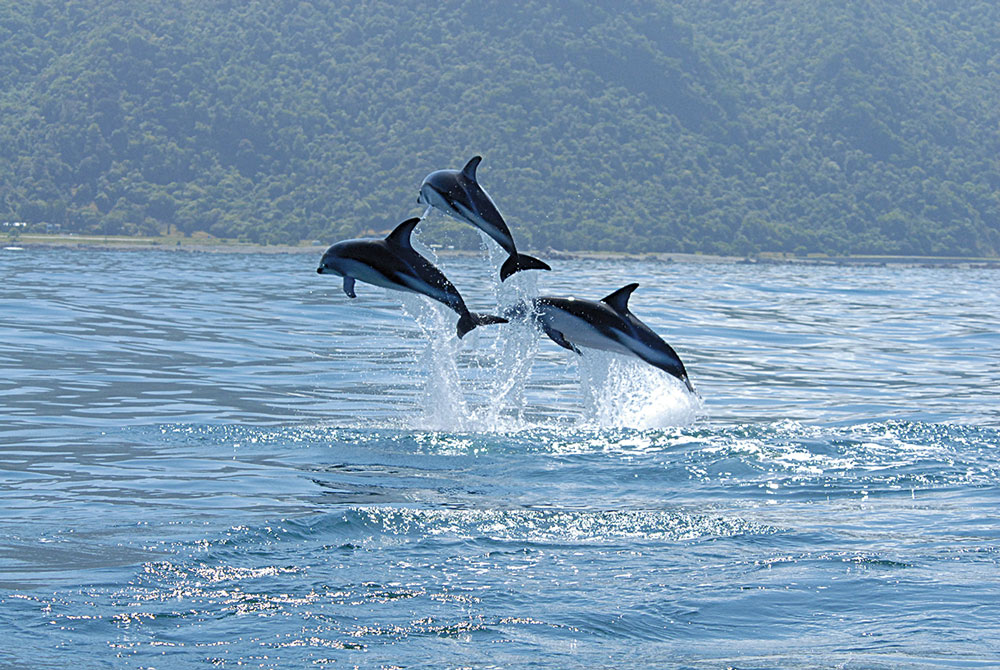
Some species such as cetaceans have a social life, communicate with each other, and are intelligent, but do not have tools like our hands nor the ability to create fire or modify their physical environment. / Dr Mridula Srinivasan
Cultural evolution changes social organisation and collective behaviour
Cultural evolution modifies the organisation of human societies. The main steps are known: the Australopithecus were hunter-scavengers and gatherers. Some hunter-gatherer humans have persisted to this day and, contrary to common belief, are often very well nourished, healthy, and have many hours of leisure time. But they have been relegated to marginal spaces, fought against and often exterminated by more numerous societies based in an ever-increasing transformation of the environment: nomadic breeders, urban farmers and herdsmen, industrial societies, and a globalised economy. Agriculture makes it possible to keep cities and armies independent from production, but malnutrition has been the norm. The alternation of good or normal production years with periods, sometimes several years long, of little or no production has made hunger and its consequences commonplace (Salrach, 2009).
Hunter-gatherer groups are small and quite egalitarian. When populations grow, cohesion is reinforced with hierarchical power structures, leadership, police, justice, and with moral norms: a nation ideology, army, religion, etc. The conformation of an individual is not a free personal choice, and its absence is punished. In theory, cultural group selection may benefit the components of the more cohesive groups, but in practice the benefits tend to accumulate for the individuals who dominate the hierarchy. Inequality is counter-cohesive. Therefore, dominant individuals assume the role of suppliers and distribute part of their goods to avoid revolts, especially to prevent potential rivals who want to occupy the top of the hierarchy from finding support in too many subordinate individuals. This also happens in chimpanzees.
Cultural evolution modifies social behaviour in relation to, and in competition with, other groups. There are changes in beliefs, institutions, etc. The creation of larger and larger societies stratified into classes has been linked to resource problems and to wars and expeditions to try to obtain more resources. The transformation from clusters and small settlements to empires, from local cultures to civilisations, is a self-organising social process of technological innovation and change in economic, institutional, and relationship systems, in a framework conditioned by geography, topography, and natural resources. But this framework is not fixed; we can modify it. Other species and geological or cosmic events are also able to do it.
Environmental challenges and the Anthropocene
The influence of our action has become so great that there is talk of a new geological period, the Anthropocene. There is no agreement on when it began: at the end of the last ice age; with agriculture (although its beginnings are diverse and an objective date should be specified); in 1610 (when the CO2 minimum was registered in the atmosphere: the Old and New World were already connected and a «global system» was being established); in 1964, with the C14 peak due to nuclear tests (see Lewis & Maslin, 2015). But what matters here is that humans have sufficiently changed the world to define a new geological period. Plastic bags have been seen 11,000 meters deep in the Mariana Trench, and there is rubbish floating in space, evidence of the biospheric reach of the human footprint.
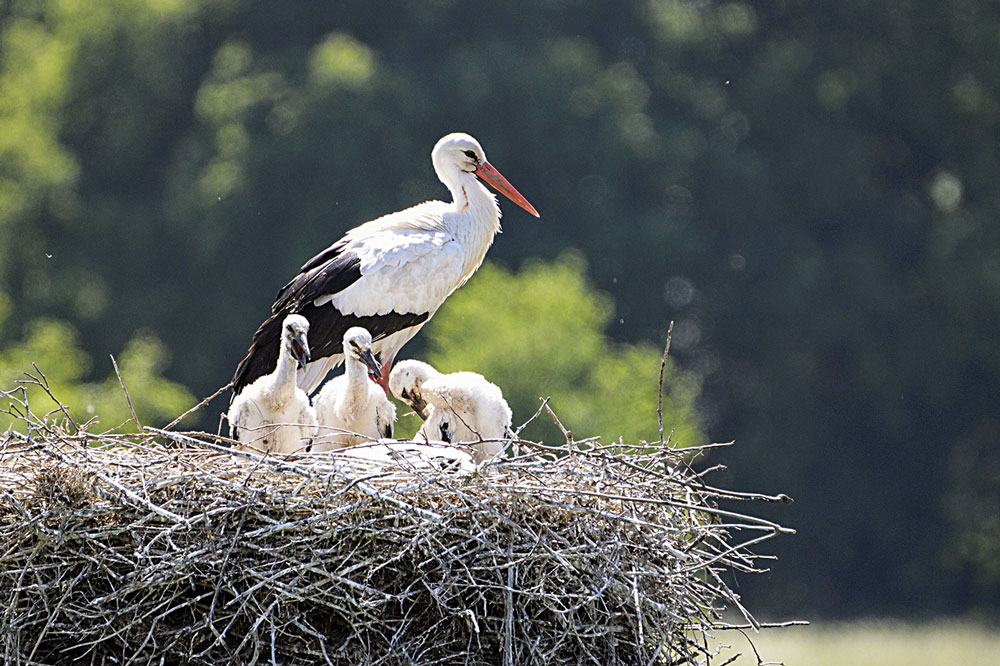
Species such as social insects or birds transform the environment to build nests or colonies. But none of them has reached the level we humans have. / Maurice Schalker, Unsplash
From the environmental point of view, nine possible planetary limits are accepted (although the threshold values that should not be exceeded are debatable). The Stockholm Resilience Centre (Rockström et al., 2009) lists them as follows: (1) stratospheric ozone depletion; (2) loss of biosphere integrity; (3) chemical pollution and the release of novel entities; (4) climate change; (5) ocean acidification; (6) freshwater consumption and the global hydrological cycle; (7) land system change; (8) nitrogen and phosphorus flows to the biosphere and oceans; and (9) atmospheric aerosol loading. These items are interrelated (e.g., the link between climate change and the water cycle or between climate change and sea acidification) and accelerating retroactions can be established. The main environmental challenges would be to stop or reverse the current trends in each instance, always considering that each item represents an extremely complex phenomenon.
Environmental research can help a lot. We already understand that all these issues require approaches from a variety of disciplines and that follow-up observations, laboratory experimentation, and field work on these processes and their effects on ecosystems are needed. Ecologists compare long-term ecosystem dynamics across the globe, biodiversity and genetic losses, alterations in ecosystem composition, effects of pollutants on food webs, alterations in species phenology and distribution, quantification of basic processes in global hydrological and biogeochemical cycles, etc., using a range of techniques, from molecular to ecosystem-scale flow analysis and remote sensing techniques. Ecological knowledge is growing fast.
But the problems are social. The main causes of the dangerous trends identified are: (a) the growth of per capita resource consumption and waste emission activity in most parts of the world; (b) the human population has quadrupled in barely a century and continues to increase; and (c) the population is leaving the countryside: until 2030, every month there will be 2.3 million more people living in cities (UNCTAD, 2017), which increases the need for horizontal transport and, consequently, exosomatic energy. The greatest difficulty is the acceleration of change: we are riding an unbridled cultural evolution.
Are there solutions?
We must decarbonise the economy as much as possible and commit to a circular economy which aims for zero waste: many things can and must be done. Technology generates new risks but also possibilities for improvement (although each step aimed at solving a specific problem can have unforeseen consequences in the socio-ecological system). There are also serious cultural, social, and economic obstacles. In economic terms, the recent trend towards the very rapid growth of inequality (Piketty, 2014) implies that decisions that affect billions of individuals are in the hands of only a few people and corporations, diminishing national and supranational control: the richest dominate the IMF and the World Bank. However, there has been a shift from a productive to a speculative economy: investment and divestment decisions are made in seconds, affecting many people everywhere in the world. For the first time, the economy is losing jobs because of technological progress (until now, automation eliminated low-level jobs but generated new activities and the overall balance was positive; robotisation has changed this, perhaps forever).
«Culture makes it possible to use resources from the environment to feed on, take refuge, or reproduce. Sometimes, however, human action leads to the depletion of local resources»
From the social point of view, with the fall of the USSR in 1989, it seemed that neoliberalism and Western civilisation (secular democratic states, individual rights, etc.) had won. Environmental and feminist movements oppose the system but have only achieved partial successes and new movements like Occupy Wall Street are not currently alternatives. But Western civilization is losing momentum very quickly in the face of new competitors: not only the civilisations represented by China and Islam, but also those from Russia, India, Japan, and Latin America, among others. The clash of civilisations implies that the presumed Western victory has given way to a very different situation: the values accepted by the most demographically active part of humanity are not Western values. We do not know the consequences this may have for responding to environmental challenges. If, in the scale of values, the collective (national interest, for example) weighs more than the individual, human rights will not benefit, but perhaps agreements on the global defence of the biosphere are feasible. For example, China is taking major steps to address its very serious environmental problems.
However, non-Western countries have tended to privilege economic and social rights (including the right to development) over political and civil rights and, of course, the defence of the environment. The West tried to deny development aid to countries that were not particularly sensitive in the area of human rights, but at the 1993 Vienna conference, most believed that the right to development should prevail, and references to freedom of expression, press, assembly, worship, etc. disappeared from the final documents (Haynes, 2018; Huntington, 1997). The West has not been able to prevent countries such as China, India, or Pakistan from having nuclear weapons, and will not prevent others from joining the club. Worse still, there is a risk of nuclear terrorism and an accumulation of hatred that cannot be ignored. We do not know if the Anthropocene began when we underestimated the significance of the C14 peak signal in 1964, but it could end with a nuclear collapse. The danger exists and may be greater than the planetary limits outlined above.
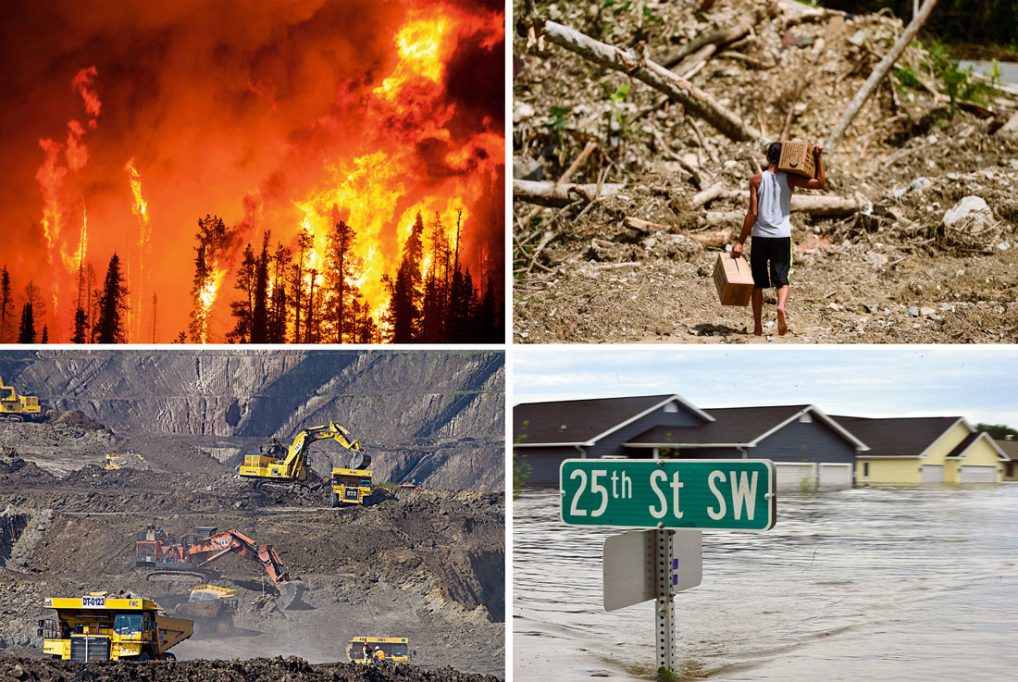
From an environmental perspective, the main environmental challenge would be to reverse phenomena such as climate change. From left to right and from top to bottom, a wildfire in Idaho (USA) in summer 2016; the consequences of hurricane Maria in Puerto Rico in 2017; a coal extraction operation in Indonesia; and flooding in North Dakota (USA) in 2011. / US Department of Agriculture / US Air Force photo by Master Sgt. Joshua L. DeMotts / Dominik Vanyi , Unsplash / US Air Force Photo by DVIDSHUB (CC BY 2.0)
Environmentalism suffers from an excessively Western view of the world. Although the United States will remain the owners of the largest number of weapons of mass destruction (and the most powerful ones) for some time, their economic and social power (and that of their European, Canadian, Australian, and New Zealand associates) is rapidly declining. Strategies for the defence of the biosphere must find useful arguments against completely different cultures and take advantage of the traditions of these civilisations, which may involve a sense that humans belong to nature – a sense that has been lost in the West (Selin, 2003). But they will not be able to rely on tolerance for free expression, which will complicate the struggle. In any case, a form of native environmentalism is developing in countries such as China (see Hernández, 2017; Yale Center for the Study of Globalization, 2004).
In cultural, social, and economic spheres, messages and solutions must be offered that are not perceived as Western impositions. This is not easy. What I have tried to explain here is that we often transform the world without knowing where we are heading. Naturally, we need to progressively better our understanding of the links between how nature works, how our minds are organised, the real distribution of power, and our various ways of feeling and organising. This path calls for a tremendous effort of mutual understanding between individuals and civilisations, and for changes in institutions, and we still do not know if we will be able to do this. However, what other project can help our understanding better than avoiding a global economic collapse caused by an environmental crisis? History is full of the remnants of civilizations amidst the sands of deserts. The risk of a global collapse exists, and it is a risk for the entire species. We all need to learn to direct cultural evolution as best we can. There is no other planet, not for billions of people, and so, we must learn to understand each other.
REFERENCES
Boyd, R., & Richerson, P. J. (1985). Culture and the evolutionary process. Chicago: University of Chicago Press.
Cavalli-Sforza, L. L., & Feldman, M. W. (1981). Cultural transmission and evolution. Princeton: Princeton University Press.
Conrad, J. (1924). Geography and some explorers. National Geographic, 45(3), 241–274.
Geertz, C. (1988). La interpretación de las culturas. Barcelona: Gedisa. (Original work published 1973).
Haynes, J. (2018, May 1). Huntington’s «Clash of civilizations» today: Responses and developments. E-International relations. Retrieved from https://www.e-ir.info/2018/05/01/huntingtons-clash-of-civilizations-today-responses-and-developments/
Hernández, J. C. (2017, July 12). China’s religious revival fuels environmental activism. The New York Times. Retrieved from https://www.nytimes.com/2017/07/12/world/asia/mao-mountain-china-religion-environment.html
Huntington, S. P. (1997). The clash of civilizations and the remaking of world order. New York: Simon & Shuster.
Lewis, S. L., & Maslin, M. A. (2015). Defining the Anthropocene. Nature, 519, 171–180. doi: 10.1038/nature14258
Mesoudi, A. (2015). Cultural evolution: A review of theory, findings and controversies. Evolutionary Biology, 43(4), 481–497. doi: 10.1007/s11692-015-9320-0
Piketty, T. (2014). Capital in the twenty-first century. Cambridge, MA, and London: Harvard University Press.
Rivera, J. E. (1989). Carta a Henry Ford. In P. González Rodas, Una carta desconocida [1927]. Revista Universidad de Antioquia, 215.
Rockström, J., Steffen, W., Noone, K., Persson, A., Chapin, F. S., Lambin, E., ... Foley, J. (2009). Planetary boundaries: Exploring the safe operating space for humanitiy. Ecology and Society, 14(2), 32. Retrieved from https://www.ecologyandsociety.org/vol14/iss2/art32/
Salrach, J. M. (2009). La fam al món. Passat i present. Vic: Eumo editorial.
Selin, H. (Ed.). (2003). Nature across cultures: Views of nature and the environament in non-Western cultures. Dordrecht: Kluwer Academic Publishers.
Serrallonga, J. (2004). Evolució biològica versus evolució cultural: Ecologia i comportament dels primers homínids. In Fundació Alsina i Bofill (Ed.), Dissetè Congrés de Metges i Biòlegs de Llengua Catalana (pp. 207–233). Barcelona: Fundació Alsina i Bofill. Retrieved from https://taller.iec.cat/cmibllc/fons/17/17.01.022.pdf
UNCTAD. (2017). Population. In UNCTAD, Handbook of statistics 2017 (pp. 60-69). New York: United Nations. Retrieved from https://unctad.org/en/PublicationChapters/tdstat42_FS11_en.pdf
Yale Center for the Study of Globalization. (2004). Global environmentalism hits China. Retrieved from https://yaleglobal.yale.edu/content/global-environmentalism-hits-china

